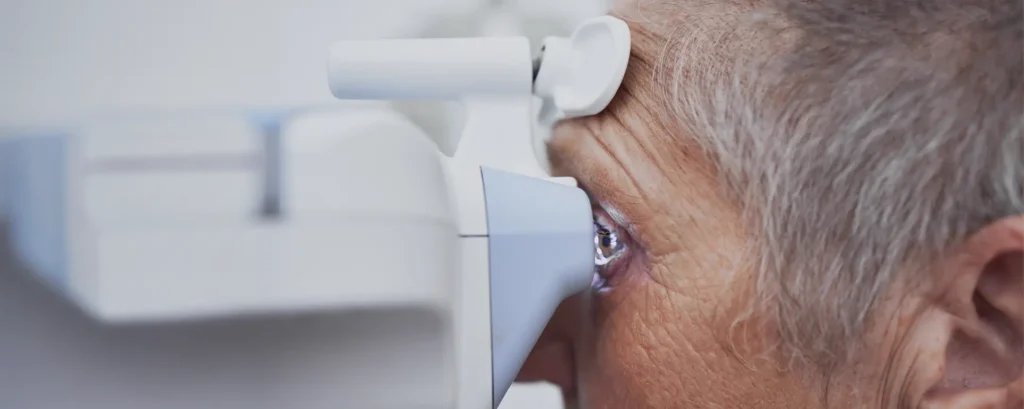If you’ve recently had cataract surgery and your eyesight still isn’t where you hoped it would be, you’re not alone — and you’re certainly not out of options. Cataract surgery is one of the most successful procedures in modern medicine, with millions of people each year enjoying clearer, brighter vision. But that doesn’t mean it’s always perfect straight away. Some patients find that their vision still feels off, or that glasses are still needed, even after the operation. That can feel disappointing, especially if you were expecting crystal-clear, glasses-free vision.
Let’s take a deep dive into why this happens, what it means for your eyes, and most importantly — what can be done about it.
Why Cataract Surgery Isn’t Always 20/20 Straight Away
Cataract surgery replaces the clouded natural lens of your eye with an artificial intraocular lens (IOL). This new lens is selected based on your eye measurements, and for many people, the results are fantastic. But vision is a delicate thing — and several factors can influence how clear your sight is after surgery.
Imperfect Pre-Surgical Measurements
Your eye is a complex structure, and determining the exact power of the lens you’ll need after surgery involves some high-precision measurements. These measurements usually include the length of your eye, the curve of your cornea, and how light bends through your eye. But even with today’s advanced biometric technology, there’s still a margin of error — especially in people who’ve had laser eye surgery in the past, or those with irregular corneas or long or short eyeballs. A tiny difference can mean you end up slightly over- or under-corrected, which might result in blurred vision or the need for glasses.
Astigmatism That Wasn’t Fully Corrected
Astigmatism is when the cornea is more rugby-ball shaped than football-shaped, causing vision to blur at various distances. Cataract surgery can often correct this with special toric IOLs or additional incisions in the cornea. However, if astigmatism wasn’t addressed fully — either because it was mild, or because the toric lens didn’t sit perfectly in place — you may still experience some visual distortion afterwards.
Your Eye’s Healing Process
Everyone heals differently. In some people, the eye tissue heals in a way that slightly shifts the position of the new lens, or changes the curvature of the cornea. This can affect how light focuses in your eye and may lead to vision that isn’t quite as sharp as it was immediately after surgery. While this isn’t common, it’s a known cause of unexpected visual outcomes.
Residual Refractive Error: What It Means

“Residual refractive error” simply means that after cataract surgery, there’s still a small degree of short-sightedness, long-sightedness, or astigmatism that hasn’t been fully corrected. This can lead to blurred vision, particularly at certain distances, and might make you feel that the surgery hasn’t completely “worked”.
The good news? It doesn’t mean the surgery was a failure — just that your eyes may need a little extra help to reach their best potential. Think of it like getting a bespoke suit — occasionally it still needs a few minor adjustments before it fits just right.
Posterior Capsule Opacification: The So-Called ‘Secondary Cataract’
If your vision was great after surgery but has started to go cloudy again weeks or months later, you might be dealing with something called posterior capsule opacification (PCO). This isn’t a true cataract coming back — the cataract was removed during surgery and won’t grow again. But what can happen is the thin membrane that holds your new lens in place becomes cloudy over time, a bit like condensation on a window.
PCO is quite common, and very treatable. A quick, painless laser procedure called YAG capsulotomy can clear the cloudy capsule and restore vision within minutes. If this is the reason behind your less-than-perfect eyesight, you’re likely to notice a big improvement very quickly.
Common Signs Your Vision Isn’t Where It Should Be
So how do you know if your post-surgery vision is off track? Here are some of the common signs patients report:
- Still needing glasses for daily tasks, like reading or driving
- Blurry vision at certain distances, even with new lenses
- Ghosting, halos, or glare that persists beyond the expected recovery window
- A return of cloudy or dim vision weeks or months after surgery
- Eyestrain or headaches, especially when focusing for long periods
If any of these sound familiar, it’s a good idea to have your vision reassessed. A follow-up with your surgeon or optometrist will help pinpoint the issue and guide you to the right solution.
What You Can Do About It

If cataract surgery hasn’t fully corrected your vision, don’t worry — there are several safe and effective options available.
- Prescription Glasses or Contact Lenses
In many cases, a simple pair of glasses can clear up residual blur. This is especially common if the IOL was designed for distance, and you now need help with near tasks like reading or using a phone. Some people are perfectly happy using readers or light prescription lenses post-surgery — especially if it avoids further procedures. - Laser Vision Correction (LASIK or PRK)
If you’re eager to ditch the glasses, laser enhancement may be an option. Procedures like LASIK or PRK can fine-tune your vision by reshaping the cornea, correcting any leftover refractive error. These are generally safe and effective in post-cataract patients — assuming your eye is otherwise healthy and stable. Your surgeon will typically wait a few months after cataract surgery to ensure your vision has settled before considering this. - Piggyback IOLs
In some cases, especially where there’s a significant refractive error left after surgery, your surgeon might recommend a second intraocular lens. These “piggyback” lenses sit in front of or behind your primary IOL and are used to fine-tune the visual outcome. While less common than laser touch-ups, they can be useful in more complex cases — particularly if laser correction isn’t suitable. - Lens Exchange (IOL Replacement)
If the issue is directly related to the lens that was implanted — for example, it’s the wrong power or causing visual distortions — it may be possible to remove and replace it. This is a more invasive option and carries additional risks, so it’s usually only done when other approaches aren’t feasible.
What to Expect from a Post-Surgery Eye Exam
If your vision isn’t where it should be after cataract surgery, your first step is a detailed eye exam. This might include:
- Refraction testing to check for glasses prescription
- Corneal topography to map the shape of your cornea
- Ocular coherence tomography (OCT) to check the retina and macula
- Lens positioning checks to see if the IOL has shifted
This comprehensive evaluation helps your ophthalmologist determine what’s going on and whether a secondary procedure or simple visual aid is the best next step.
How Often Does This Happen?
While it’s not the norm, it’s also not rare for patients to need glasses or minor tweaks after cataract surgery. Studies suggest that up to 25–35% of patients will have some level of residual refractive error post-op, depending on the population, technique, and IOL used. Fortunately, most of these issues are easily correctable — and very few people are left significantly impaired.
Setting Expectations: Why Perfect Vision Isn’t Guaranteed

Even with the most advanced technology, predicting exactly how an individual eye will heal is difficult. That’s why no surgeon will ever promise “perfect” vision after surgery — only the best outcome possible given your individual eye structure and health.
Factors like dry eye, macular degeneration, glaucoma, or previous surgeries can all affect how well your vision recovers — even if the cataract itself was removed flawlessly. Some people also expect to see like they did at age 25, which may not be realistic.
Setting realistic expectations before surgery — and understanding the options afterwards — makes a big difference to overall satisfaction.
Premium IOLs and Multifocal Lenses: Are They Worth It?
Some patients opt for premium intraocular lenses like multifocal or trifocal lenses, which are designed to reduce dependence on glasses. These lenses split light to offer clear vision at multiple distances, but they’re not perfect either. Some patients report haloes, reduced contrast, or difficulties in low-light conditions.
If you’ve chosen one of these lenses and are disappointed with the results, it’s worth discussing your concerns with your surgeon. In some cases, neuroadaptation (your brain getting used to the new visual input) can take weeks or months. In others, a tweak or even a lens exchange may be the best course.
Managing Disappointment: You’re Not Alone
It’s completely natural to feel frustrated or even a little let down if your cataract surgery didn’t fully fix your vision. You may have looked forward to the procedure with high hopes — and while it likely improved your sight, it may not have gone quite far enough.
The key is not to give up. The vast majority of patients who seek further help — whether through glasses, laser tweaks, or minor procedures — can achieve excellent results in the end. Be honest with your eye specialist about what’s bothering you. There’s nearly always a path forward.
FAQs: One-Paragraph Answers
- Is it normal to need glasses after cataract surgery?
Yes, it’s actually quite common to need glasses after cataract surgery, even if the operation itself was successful. Most people who receive monofocal intraocular lenses (IOLs) will still require glasses for either near or distance vision depending on which focus was chosen for the implant. Even with premium multifocal or toric lenses, some patients may still notice a slight need for correction due to residual refractive error, astigmatism, or natural variation in healing. While cataract surgery significantly improves overall vision, it doesn’t always eliminate the need for all visual aids — and that’s considered a normal part of the recovery experience for many patients. - Why is my vision still blurry after surgery?
Blurry vision after cataract surgery can have several causes, and understanding the timing and nature of the blur is key. In the first few weeks, it could simply be due to swelling, healing, or dryness in the eye. But if the blurriness persists or worsens after a few months, it may be related to residual refractive error, posterior capsule opacification (PCO), or even undiagnosed conditions such as macular degeneration or astigmatism that wasn’t fully corrected during surgery. A proper eye examination can determine the exact cause and help guide the next steps for improving clarity. - How long should I wait before seeking a correction?
It’s generally advised to wait at least 6 to 12 weeks after your cataract surgery before considering corrective options like glasses, laser touch-up procedures, or lens enhancements. During this time, your eye is still healing and your vision can continue to stabilise. Attempting to correct vision too early may lead to inaccurate measurements or unnecessary procedures. Your surgeon will typically assess your eye health and visual acuity during follow-up visits and let you know when your vision has plateaued enough to safely move forward with any additional corrections if needed. - Can LASIK be done after cataract surgery?
Yes, LASIK or other forms of laser eye surgery like PRK can often be used to fine-tune vision after cataract surgery if there is residual refractive error. This is especially useful for patients who want to reduce their dependence on glasses but did not achieve the desired clarity after receiving their intraocular lens. Not everyone is a suitable candidate though — your corneal thickness, dry eye status, and overall eye health need to be carefully evaluated. If you are eligible, laser enhancement can offer a precise and effective way to improve your vision further after cataract removal. - What is a YAG capsulotomy?
A YAG capsulotomy is a painless laser procedure used to treat a common post-surgery complication known as posterior capsule opacification (PCO), which is often referred to as a “secondary cataract.” This occurs when the thin membrane that holds your new lens in place becomes cloudy months or even years after the initial operation, causing vision to become blurred or hazy again. The YAG laser creates a small, clear opening in the membrane to restore the clarity of your vision. The treatment takes only a few minutes and doesn’t require incisions or downtime, and most patients notice improvement within a day or two. - What if my IOL is the wrong power?
If your implanted intraocular lens turns out to be the wrong power and is causing significant vision problems, there are still options to address it. The first step is to verify the extent of the mismatch using precise eye measurements, and if necessary, your surgeon may recommend either laser vision correction to fine-tune the result or, in some cases, a second procedure such as IOL exchange or a piggyback lens implant. While an IOL exchange is more invasive and carries greater risk than a laser enhancement, it can be very effective in select cases where the error is too large to fix non-surgically. - Will my vision improve on its own over time?
Some improvement in vision can occur naturally during the initial healing phase after cataract surgery, particularly within the first few weeks to months. Swelling, inflammation, or dry eye symptoms can all cause temporary blur that often resolves with time and proper aftercare. However, if your vision remains consistently blurry beyond the typical recovery window, it’s unlikely to improve significantly without further intervention. In such cases, it’s best to have your eye assessed to determine whether glasses, a YAG laser, or a secondary procedure may be necessary to optimise your vision. - Can dry eyes affect my post-op vision?
Yes, dry eye is a surprisingly common cause of blurred or fluctuating vision after cataract surgery. The surgery itself — particularly the use of eye drops and light from the operating microscope — can temporarily disrupt the tear film and cause irritation or dryness. This can lead to a gritty sensation, eye fatigue, and variable visual clarity. Fortunately, dry eye after surgery usually responds well to lubricating drops, punctal plugs, or anti-inflammatory treatments. If managed properly, most patients find that their vision improves as the eye surface stabilises and heals. - Should I see my surgeon if I’m not happy with my results?
Absolutely — if your vision after cataract surgery isn’t meeting your expectations, a follow-up appointment with your surgeon is the best way to get answers and explore solutions. Your eye will be thoroughly examined to determine whether there’s any residual refractive error, a capsular opacity, or another issue such as dry eye or retinal disease that might be affecting your sight. The surgeon can then talk you through the options available — from a change in glasses to laser correction or even lens replacement, depending on your situation. Being proactive is key to achieving the best outcome. - Can London Cataract Centre help if I had surgery elsewhere?
Yes, at London Cataract Centre we frequently see patients who’ve had cataract surgery elsewhere and are experiencing vision concerns, or simply want a second opinion. Whether you’re dealing with residual blur, light sensitivity, or uncertainty about your options, we can provide a thorough post-operative assessment and offer solutions tailored to your needs. We work with both NHS and private patients, and welcome anyone looking for reassurance or further treatment. To book a consultation, feel free to contact us on 020 7000 3193 — we’re happy to help you get the clarity you deserve.
Final Thoughts: Take the Next Step with Confidence
Cataract surgery is a life-changing procedure — but if your vision still isn’t perfect, don’t panic. Whether it’s glasses, a quick laser fix, or another solution entirely, there are plenty of ways to get your sight to where it needs to be.
At London Cataract Centre, we’re here to help you explore every option. From advanced lens planning to post-operative enhancements, we work closely with patients to ensure the best possible outcome — even if it takes a few extra steps.
Your journey to clear, confident vision doesn’t end with surgery. Sometimes, it’s just getting started.
References
- Ameen, A., Lau, C., & Srinivasan, S., 2022. Refractive outcomes after cataract surgery: analysis of residual refractive errors and risk factors in 1,578 patients. BMJ Open Ophthalmology, 7(1), e000914. Available at: https://bmjophth.bmj.com/content/7/1/e000914 [Accessed 14 Jul. 2025].
(Supports: incidence and causes of residual refractive error post-surgery) - Konopińska, J., Młynarczyk, M., Dmuchowska, D.A., & Obuchowska, I., 2021. Posterior capsule opacification: a review of experimental studies. Journal of Clinical Medicine, 10(13), 2847. Available at: https://www.ncbi.nlm.nih.gov/pmc/articles/PMC8269180/ [Accessed 14 Jul. 2025].
(Supports: pathophysiology and incidence of PCO) - EyeWiki, 2025. Refractive Error After Cataract Surgery. Available at: https://eyewiki.org/Refractive_Error_After_Cataract_Surgery [Accessed 14 Jul. 2025].
(Supports: causes, detection, and management strategies for residual refractive error) - Lin, S. & Fernandes, P., 2020. Prevention and correction of residual refractive error after cataract surgery. Journal of Clinical Ophthalmology & Research, 5(1), pp.45–50. Available at: https://journals.lww.com/jcor/fulltext/2017/05010/prevention_and_correction_of_residual_refractive.11.aspx [Accessed 14 Jul. 2025].
(Supports: corrective options—LASIK, piggyback IOLs, lens exchange) - Spalton, D.J., 1999. Posterior capsular opacification after cataract surgery. Eye, 13, pp.489–492. Available at: https://www.nature.com/articles/eye1999127 [Accessed 14 Jul. 2025].
(Supports: historical and current perspectives on PCO prevalence and management)

